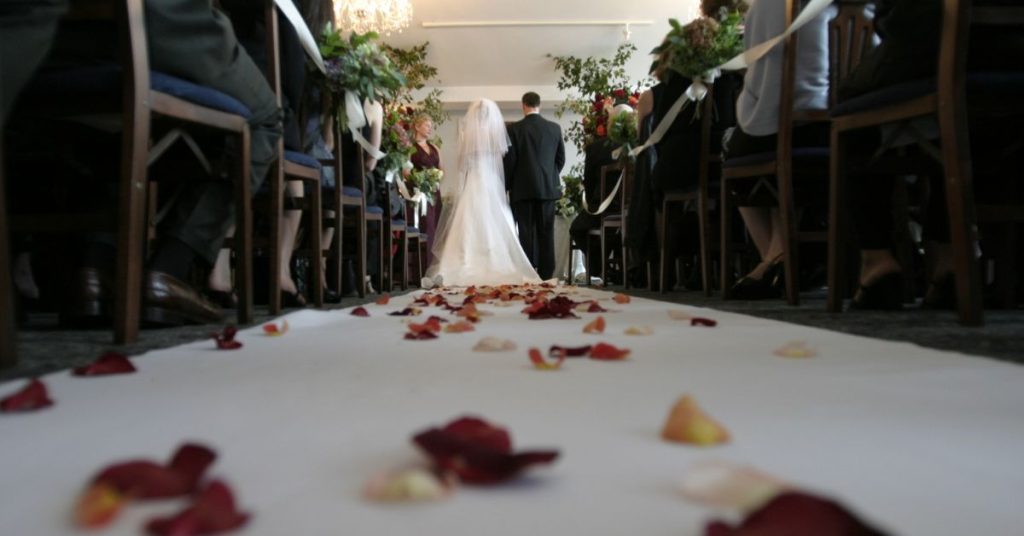Weddings are a wonderful fusion of tradition, celebration and personal style. Among the first steps of this special journey are your wedding invitations. They are not merely a vehicle for communicating the when and where of your upcoming wedding, but they are a reflection of you as a couple, setting the tone for the event to come. As such, the art of crafting the perfect wedding invitation requires both an understanding of tradition and an eye for personal touches.
In ‘The Ultimate Guide: Mastering Wedding Invitation Etiquette Like an Expert’, we aim to unravel the complexities of wedding invitation etiquette, offering clear, concise guidance to ensure your invites not only inform but impress and delight your guests. Whether you’re after a formal tone, a casual feel, or something entirely unique, this guide will provide you with the key information you need to send out impeccable wedding invitations.

Understanding the wedding invitation basics
Before diving into the nuanced details of wedding invitation etiquette, it’s important to understand the basic elements that your invitation should encompass. These include the names of the bride and groom, the hosts (if different), the ceremony’s date, time and location, the reception details, and the RSVP information. The style and theme of your wedding should shine through in the design and wording of the invitation, setting the tone for the event and giving your guests a tantalizing glimpse of what’s to come. By nailing these basics, you’re well on your way to mastering the art of wedding invitation etiquette.
Timelines are key
Adherence to established timelines is another critical aspect of wedding invitation etiquette. Generally, wedding invitations should be sent out six to eight weeks prior to the wedding date, allowing guests ample time to arrange their schedules, book travel and accommodation, and send their RSVPs. The latter should be requested back at least three weeks before your wedding, ensuring you have a finalized guest count for your vendors. For destination weddings or weddings during holiday seasons, it’s advisable to send invitations even earlier, usually three months ahead. Furthermore, save-the-date cards should be sent six to eight months in advance, or even up to a year for destination weddings. This timeline serves as a respectful gesture to your guests, allowing them to prepare and plan for your special day.
Choosing the right wording
Choosing the right wording for your wedding invitations is not just about conveying the necessary information, but it’s also about capturing the spirit of your special day and the relationship you share as a couple. Traditional wedding invitation wording often follows a certain format, typically starting with the hosts’ names, followed by a formal request to attend the wedding, the names of the couple, and the details of the event. However, modern invitations have become more flexible, allowing for creativity and personalisation. It’s essential to maintain a balance between expressing your individual style and adhering to proper etiquette. Do remember to keep the tone respectful and the information clear. Ultimately, the wording you choose should reflect your personality and the atmosphere you wish to create for your special day.
Addressing your invitations
Addressing your wedding invitations properly is a vital part of wedding invitation etiquette. While it may seem like a small detail, the way you address your invitations can set the tone for your entire event. Traditionally, guests’ names are written in full, with social titles for adults. For example, ‘Mr. John Smith’ or ‘Dr. Jane Johnson’. Married couples are addressed together, ‘Mr. and Mrs. John Smith’. If you are inviting a whole family, ‘The Smith Family’ is appropriate.
However, modern etiquette allows for first names if it’s a less formal event. Professional titles like ‘Doctor’ should be spelled out, unless the name is too long to fit on your invitation. For those in doubt, it’s better to err on the side of being too formal rather than not formal enough. Remember, each invitation should be addressed personally—it not only shows respect but also adds a touch of charm to your wedding preparations.
The art of the RSVP
The RSVP is a crucial component of your wedding invitation suite, allowing you to obtain a precise guest count for your event. Traditional wedding etiquette dictates that a separate RSVP card should be included with your invitation, providing clear instructions on how and when guests should respond. Typically, guests are asked to reply three weeks before the wedding. This gives you enough time to finalize seating charts and give final numbers to your vendors. Remember to include a self-addressed, stamped envelope for the guests’ convenience.
With the advent of technology, some couples now prefer online RSVPs via wedding websites or emails. Your RSVP card or instructions should also include options for guests to specify dietary restrictions or meal preferences if applicable. Mastering the art of the RSVP not only helps in your planning process, but also adds to the overall smooth running of your special day.
Navigating plus-ones and uninvited guests
Addressing the issue of plus-ones and uninvited guests can be tricky. When it comes to plus-ones, the general rule is to extend the offer to married, engaged, or long term couples. However, the choice ultimately lies with you, and it’s acceptable not to offer plus-ones, especially if you’re planning a smaller or budget-conscious wedding. To avoid any ambiguity, be clear on your invitation by either naming the invited guest’s plus-one directly, or by writing ‘and guest’.
As for uninvited guests, including children or extra friends, it’s crucial to be clear in your invitation as to who exactly is invited. If the invitation is addressed to ‘The Smith Family’, it implies that the children are invited; if it’s addressed to ‘Mr. and Mrs. Smith’, it implies that it’s an adults-only event. By setting these boundaries clearly and politely in your invitations, you can help to avoid any potential misunderstandings or awkward situations.
Crafting a thoughtful dress code
As part of your wedding invitation, you may want to indicate the dress code for the event. First, consider the style and location of your wedding – a beach wedding may call for more casual attire, while a grand church ceremony might require a more formal dress code. Include this information in a clear but polite way on your invitations, possibly within the lower right corner or on a separate details card. Avoid overly specific demands, but feel free to suggest colors or styles in keeping with your wedding’s theme. Be mindful of your guests’ comfort, ensuring your dress code is appropriate for the expected weather conditions.
Regulating guest lists and invitation quantities
Managing your guest lists and regulating the quantities of your invitations are key steps in ensuring a smooth wedding planning process. Start by drafting an initial guest list, bearing in mind the capacity of your venue and your budget constraints. It’s common to have an ‘A-list’ and a ‘B-list’ of guests, where the ‘A-list’ includes must-have attendees, and the ‘B-list’ comprises those you would like to invite if space and budget permit.
When ordering your invitations, it’s important to note that not every guest needs an individual invite; families or couples can receive one invitation. However, it’s wise to order extra invitations to account for errors or last-minute additions. As a guide, consider ordering approximately 20% more invitations than you think you need. By carefully regulating your guest lists and invitation quantities, you can avoid common hiccups and ensure all your loved ones are included in your special day.
When to send bridal shower and rehearsal dinner invites
Bridal shower invitations should typically be sent out four to six weeks in advance, giving guests plenty of time to RSVP, buy gifts, and arrange any necessary travel or accommodation. The guest list for this event usually includes close female friends and family, but today’s norms are flexible and can certainly include men as well. On the other hand, rehearsal dinner invitations should be sent out immediately after the wedding invitations, or at least two to three weeks before the dinner. The guest list for this event generally includes immediate family members, the wedding party, and possibly out-of-town guests. Remember, each of these events has a different tone and purpose, so the design and wording of your invitations should reflect this, providing a hint of the unique celebration to come.
Vow renewal and second wedding invitations
For those planning a vow renewal or a second wedding, the invitation etiquette slightly varies. For vow renewals, the invitations can be less formal, and they should mention that the event is a vow renewal. For second weddings, the rules are similar to first weddings, although they might be less formal or traditional depending on the couple’s preference. All the traditional details are necessary: who’s hosting, the couple’s names, the date, time, and location. However, the tone can be more relaxed, particularly if the couple is hosting.
Invitations for smaller weddings or elopements
For smaller weddings or elopements, the invitation etiquette can be a little less formal and more personal. It’s still crucial to provide all the necessary details and follow general invitation etiquette, but the wording and design can be more personalized to reflect the intimate nature of the event. If you’re eloping, you might choose to send ‘elopement announcement’ cards after the fact. These should ideally be sent as soon after the ceremony as possible and can include a heartfelt message, a photo from your special day, and perhaps details of a post-elopement celebration if you’re planning one. No matter the size of your wedding, your invitations should always echo the personal and unique nature of your celebration.
Thank You Notes post-wedding
Once your magical day has passed, it’s time to send out thank you notes. This should be done promptly, ideally within three months of the wedding. A hand-written note on a personalized card adds a heartfelt touch. Thank your guests for their presence (or well wishes, if they couldn’t attend) and for their gift, if applicable. Remember, a well-written thank you note not only shows your appreciation but also provides a heartfelt conclusion to your wedding festivities. And there we have it, your ultimate guide to mastering wedding invitation etiquette like an expert. With these insightful tips at your fingertips, you’re now well-equipped to navigate the often complicated, but rewarding process of crafting the perfect wedding invitations.

Remember, while there are traditional guidelines and norms, your special day should be a reflection of you and your partner, so don’t be afraid to add personal touches that mirror your unique love story. From setting the tone to showing your appreciation, every step in this journey is a chance to create lasting memories. May your wedding, from invitation to the thank you notes, be as joyous and unforgettable as the lifelong commitment it celebrates. Happy planning!





